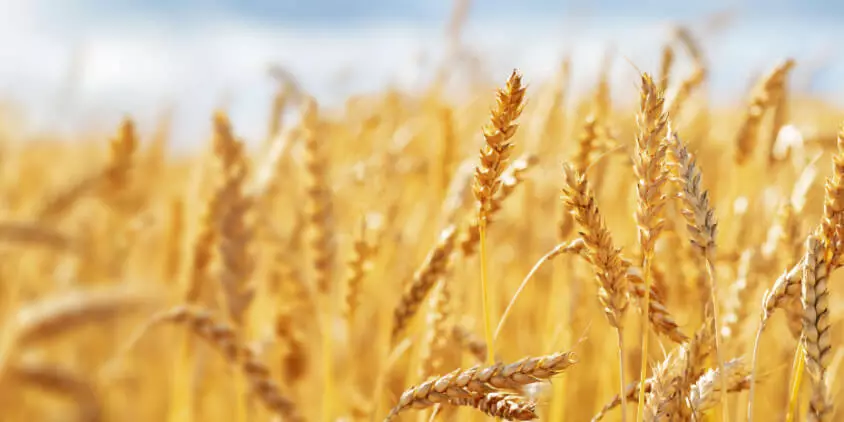
How To Grow Wheat Efficiently On A Large Farm
If you are wondering how to grow wheat, it’s necessary to first clarify that there are two main crop varieties: winter and spring. Although each has its own unique growing requirements and cultivation specifics, growing spring and winter wheat has more similarities than differences.
Good care for both species entails watering at the proper times during distinct growth stages, adding NPK fertilizers, and keeping a vigilant eye out for weeds, pests, and diseases. These and other wheat growing tasks can benefit from the use of precision farming technologies. Once the crop has reached maturity, modern agricultural machinery again comes in handy, allowing for quick harvesting and preparing the grain for storage.
When To Grow Wheat
Wheat (Triticum aestivum L.) can be divided into two distinct growing seasons: winter and spring. The crop is classified as either “spring” or “winter”, depending on when the seed is planted and when it germinates. Farmers choose the type of crops to grow based on the weather and soil conditions in their area.
Fall is when you start growing winter wheat for a summer harvest. This enables the crop to thrive in locations that experience extreme drought throughout the summer by making use of fall and winter precipitation. This cereal crop can only grow successfully in areas with milder winters and/or sufficient snow cover to prevent damage from deep, persistent freezing. To survive the late fall and winter months, young plants need to grow between 4 and 6 inches (10 and 15 cm) tall. The crop’s roots are hardy enough to last through the winter and continue growing once the temperature warms up again in the spring.
Planting in the fall may not be the best choice in harsh climes, so spring wheat is often grown in these regions instead. It also typically grows in areas that get plenty of rain in the spring and summer.
Optimal Conditions For Growing Wheat
The ideal temperature and moisture levels for growing winter and spring wheat are different from one another. However, both crop types have similar growing requirements in terms of soil composition and mineral content. Let’s start with the basic favorable conditions for wheat growth.
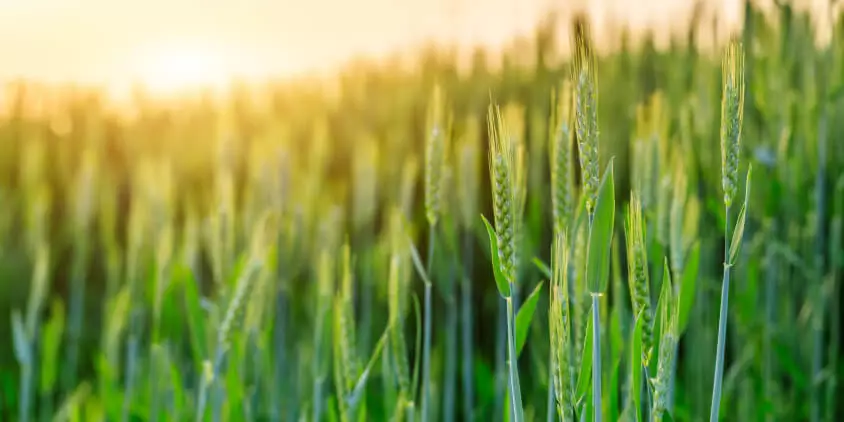
Water
The ideal amount of water required to grow a successful wheat harvest is 12–15 inches (30–38 cm) during the growing season. Climate, soil water content, the length of the growing season for particular wheat variety, and the stage of plant growth are the most important factors in determining how much moisture your crop needs.
It is considered that winter wheat’s “conditioning” makes it more adept at adjusting its development in response to water shortages, explaining why the spring crop is more sensitive to dry growing conditions. While harvests typically suffer from a lack of rain, an abundance of water may also be problematic for the growing plant. Excessive wheat growth and development brought on by overwatering throughout the vegetative stage can lead to lodging, as can excessive irrigation during the late yield production stage.
Temperature
Winter wheat is dormant during cold periods in its early vegetative stage and needs temperatures to drop to at least near freezing for the plant to enter its reproductive cycle. That is to say, a winter crop won’t yield seed until it endures a prolonged period of cold conditions, below 40°F (4°C). Temperatures exceeding 90°F (32°C) can cause heat stress in plants and lower crop production.
Spring wheat growing, on the other hand, demands a temperature between 70 and 75°F (21 and 24°C) for the best result. If we talk about the cold/warmth limits for successful cultivation, spring crop varieties may grow in temperatures as low as 40°F (4°C) and as high as 95°F (35°C). At some points in plant development, it is crucial to maintain the temperature for growing wheat within this range. For example, seed germination temperatures below the lower limit and maturation temperatures above the upper limit are both associated with reduced yields.
With the assistance of EOSDA Crop Monitoring, you can access current and past data on the weather conditions in your wheat growing fields. You may even examine detailed temperature and rainfall records dating back to 1979. The 14-day forecast includes all the information you might possibly need to plan field activities, such as the expected wind speed, wind direction, and cloud cover.


Sunlight
Sun radiation has a direct impact on growing crops. According to studies, crop yield potential is highest in places with relatively low temperatures but higher radiation . Wheat grows best in full daylight, and a productive crop needs at least six hours of sunlight daily. Winter crops grow slower, in part because of shorter days and less sunlight during the cold season.
EOSDA Crop Monitoring
Offering high-resolution satellite images for fields analytics to monitor crops health remotely!
Soil And Nutrients
Knowing in which soil wheat is grown is essential for maximizing crop yields. Deep, fertile loamy soil with good drainage and air circulation is ideal for growing any variety. On the contrary, peat types of soil, which are heavy in iron, sodium, and magnesium, prove highly unfavorable for growing this grain.
Optimal wheat growing pH is between 5.5 and 7.5 (slightly acidic and neutral soils). Low soil fertility and high salinity are detrimental soil conditions for growing wheat. Irrigated fields are more likely to have salinity issues. Plantlet viability, primary and secondary tiller production, leaf and spikelet production, and water availability can all be negatively impacted by soil salinization.
Nitrogen, potassium, phosphorus, calcium, magnesium, iron, zinc, manganese, boron, and copper are all essential nutrients for growing healthy and plentiful wheat.
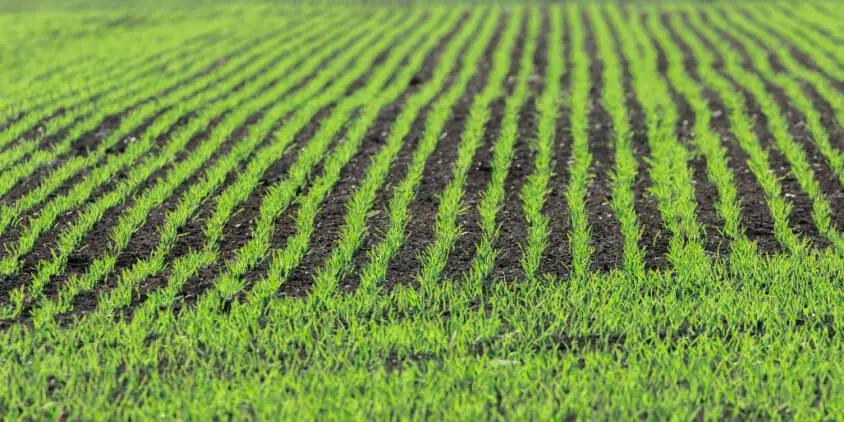
How To Plant Wheat
The first step is determining the optimal time for sowing wheat, which varies from type to type. If you want to avoid the negative effects of frost on your growing crop, you should choose a planting time for winter wheat in the late summer/early fall, roughly six to eight weeks before the first frost. The first spring months, when the soil is still chilly, are best suited for planting spring wheat. Common procedures for planting wheat include:
- Tillage. First and foremost, prepare a field before growing wheat. The recommended depth of soil tilling is 6 inches (15 cm). When you’re done, the ground should be at maximum evenness.
- Spreading compost (if needed). Light brown, overly dry, or slightly rough soil may benefit from being covered with compost. This adds nutrients to the soil, which may improve how the plants grow.
- Broadcasting seeds. This method of sowing wheat entails scattering the seed into the prepared soil, spacing it at a width of about 3 inches (7 cm). If you prefer intercropping or companion planting, increase the spacing between rows of wheat to 8 inches (20cm). The optimal wheat seed planting depth is about 0.5 inches (1 cm).
- Putting a thin soil layer over the seeds. This shields the seed from exposure to the sun and keeps birds from eating it before it can germinate. A 1.5-inch (4-cm) layer is ideal for the spring crop, while a 2.5-inch (6.5-cm) layer is recommended for the winter crop. Never cover the seeds with over 3 inches (7.5 cm) of soil.
- Watering. Water the plants as soon as possible after planting, and be sure to keep the newly planted area consistently moist until the plant sprouts and grows stronger.
Use the Field Activity Log feature in our smart crop monitoring software to organize your fieldwork and track its progress. To make sure the wheat growing process is running smoothly, you can keep tabs on jobs and workers’ comments across all your fields at once with the help of this calendar-style tool.
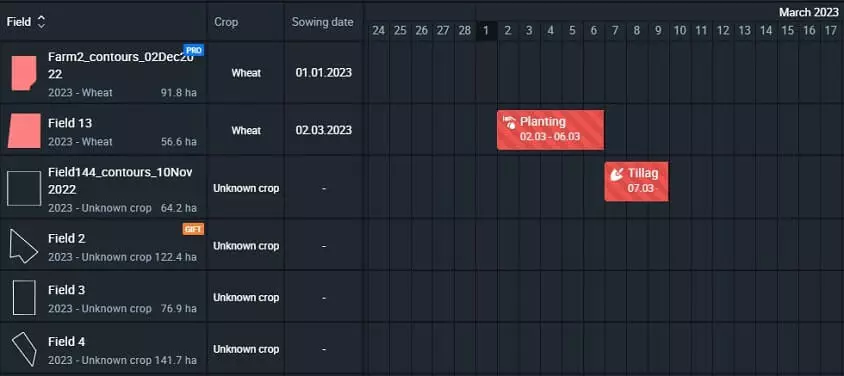
Best Care Practices For Growing Wheat
Growing this crop is a challenging endeavor. The final yield can be drastically lowered or even destroyed by a number of different causes. The following are examples of major dangers to growing wheat:
- inadequate cultivation of the soil;
- choosing an unsuitable plant variety for your region;
- improper watering techniques;
- poor disease and pest management.
There’s not much you can do if you didn’t get the soil ready for planting or used a plant variety that doesn’t grow well in your area. Still, you can manage irrigation and fertilizing, control the spread of crop diseases and pests, and otherwise take care of your growing wheat. Let’s take a closer look at the methods of crop management that will help you grow a good yield.
Fertilizing
NPK (nitrogen, phosphorus, and potassium) is a necesary fertilizer for growing wheat. Current high-yield varieties are more efficient at extracting nitrogen (N) from the soil, which makes them richer in protein . Keep in mind, that grain yield is inversely proportional to grain protein content. That’s why it’s crucial that farmers strike the ideal balance between protein composition and yield when planning their nitrogen fertilization schedules and dosages.
Fertilizer applications that are tailored to specific field conditions yield the best outcomes. Using remote sensing technologies, and in particular the EOSDA Crop Monitoring platform, makes fertilizer management in the field a lot simpler and more efficient.
Farmers can employ the variable rate application (VRA) method to add the optimal amount of nitrogen fertilizer to their growing wheat, preventing nitrogen overload and the resulting low yields. Taking the vegetation map as a guide, you may split your field into zones, determine how much nitrogen fertilizer each zone needs, and figure out how much money you’ll save in the process. By using variable rate technology (VRT) to fertilize your growing crops based on site-specific needs, you may reduce the amount of money and fertilizer that is wasted as runoff.

Watering
Watering at just the right times is crucial for efficient wheat growing. Early irrigation for winter variety contributes to quicker and more even plant emergence, stronger crop establishment, and a greater yield per land area. The spring crop also requires a lot of water throughout the germination and early root development stages. To speed up the emergence of young seedlings and foster early root development, gentle, frequent watering is recommended .
Wheat needs the most water during the flowering stage, an average of 0.19 inches (0.5 cm) per day. The soil needs to be kept damp enough before blooming begins so that the crop can thrive through the flowering stage and the early grain stage.
Wheat growing could benefit from an irrigation schedule based on satellite data showing soil moisture and plant water content. EOSDA Crop Monitoring allows for the observation of root-zone and surface-zone soil moisture dynamics. The NDMI vegetation index will also reveal the areas of the field where plants are experiencing water stress and those with an abundance of moisture, maybe due to untuned irrigation systems. With this information at your disposal, you can fine-tune your precision irrigation to the exact needs of your growing crops at any stage of their development.
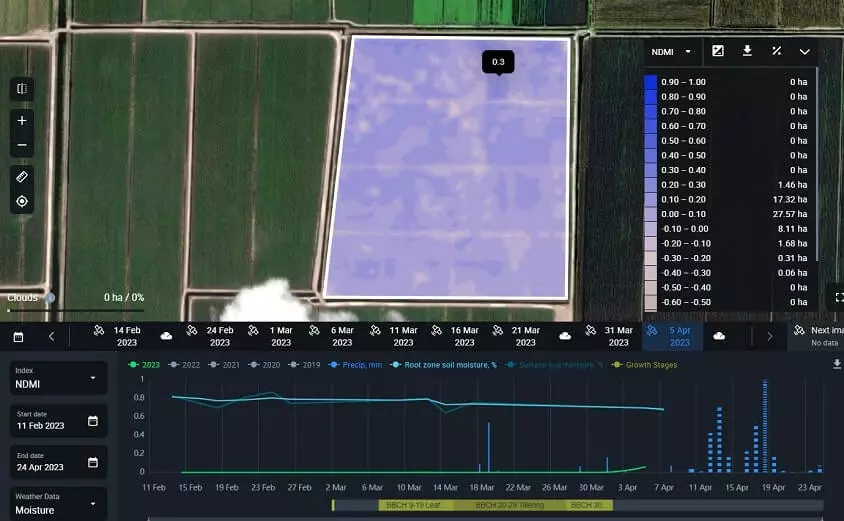
Monitoring Wheat Growth And Health
During dry years, irrigated crops are less likely to experience leaf diseases such as Septoria tritici blotch and Stagonospora nodorum blotch, as well as Fusarium head blight (head scab). However, if there is sudden rain after the irrigation, these problems may return since most fungal infections that attack crops proliferate in moist, humid environments.
You can keep tabs on the spread of diseases in wheat fields with the help of instruments provided by EOSDA Crop Monitoring. To begin, our Split View feature provides a look at the field at various times of the year, such as right before heavy rainfall and a few weeks after it. You can use this tool to monitor the vegetation index dynamics over time and observe variations in plant cover across the field. Because the vegetation indices of infected plants are far lower than those of healthy plants, we can deduce that a disease has emerged in an area where the indices have dropped precipitously.
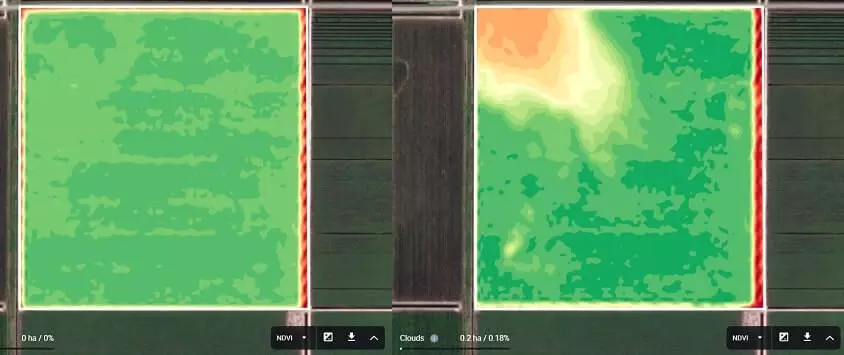
Once the trouble spot has been located, determining which disease is to blame for the decline in plant population requires firsthand observation. The EOSDA Crop Monitoring team has created a Scouting tool specifically for this purpose. With this function, you can save time and effort researching the fields by sending scouts directly to the targeted infected areas. A scout can inspect your growing wheat or any other crop and provide you with a detailed report on its condition, including a description of the issue, comments, and photographs. History and reports from scouting missions can shed light on the prevalence of a given threat in a given field, allowing for more informed preparation of field operations in subsequent growing seasons.
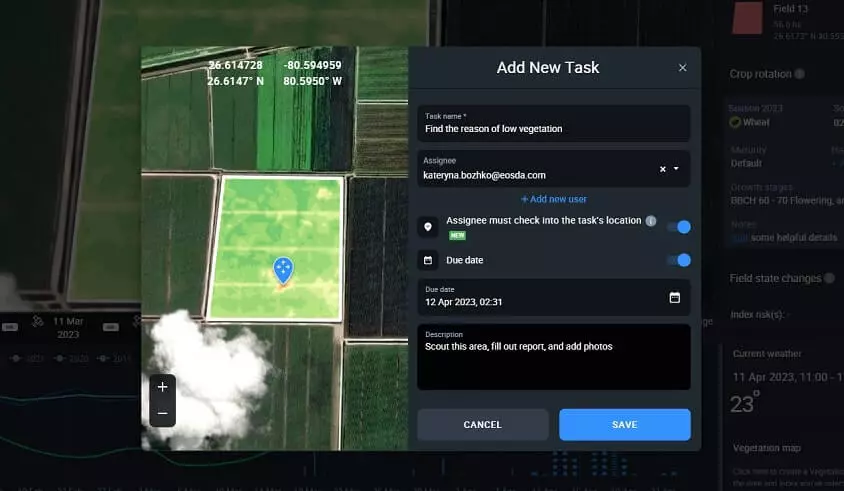
How Long Does Wheat Take To Grow?
Spring wheat needs about 100–130 days to grow, while growing winter wheat takes about 180–250 days. Winter wheat growth time includes up to 90 days during the colder months when it goes dormant.
Factors like warmth (especially soil temperature) and precipitation/irrigation affect how long it takes for the plant to grow. The winter type, for instance, needs more time to mature in frozen climates because there are more days with no potential for growth there, lengthening the wheat growth period. On the other hand, it’s possible that even a moderate lack of water during the vegetative stage can speed up the crop growing process .

How To Harvest Wheat And Handle Its Grain
Harvesting winter wheat is best in late spring or early summer, while the spring crop is reaped from the middle of summer to early fall. When there is no trace of green left in the growing crop and it has turned a golden yellow, you know it’s harvest-ready. Examining the grain’s hardness is another way to ensure the crop is ripe. Firm grain means that wheat is ready for harvest.
Harvesting Wheat
Thankfully, we no longer harvest wheat on a massive scale using manual labor. Today, combines harvest the crop from large fields. This agricultural machine simultaneously gathers, threshes, and winnows grain. The combine also cuts up the crop residue into tiny bits, which are then broadcast across the field by the rear discharge.
To prevent significant declines in grain quality, wheat should be picked as soon as it has dried down to around 12.5% grain moisture content. If you’re concerned about quality losses due to rain or poor weather, harvesting at a little higher moisture content (say, 18%) could be helpful. Grain should still be dried to a moisture content of less than 12% after harvest to prevent the risk of fungi and mycotoxins developing during storage.
Fire hazards from dry weather, high temperatures, and running machinery mean that harvesting is safer in the morning, when temperatures are lower. It’s also not a good idea to harvest just after it rains, as the grain may be overly wet and require additional drying.
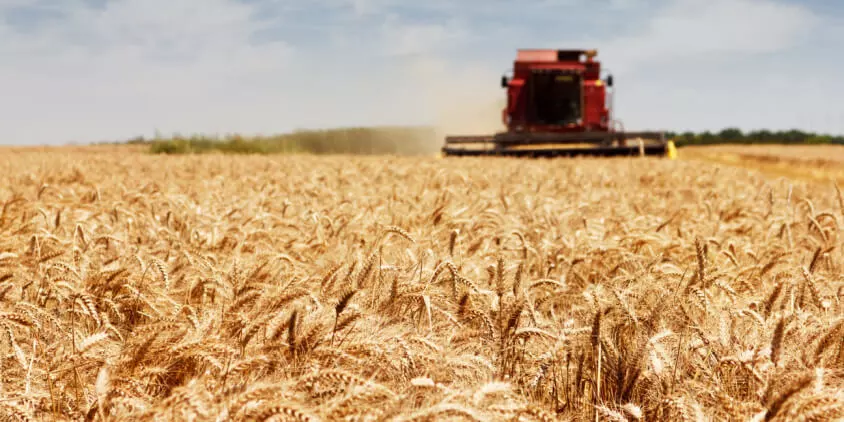
Wheat Grain Post-Harvest Handling
Moisture levels below 12%, preferably 10%, allow grains to be safely stored for long periods of time. When grain is kept in bags, its moisture level needs to be even lower, at 9%. Grain dryers are used to reduce the moisture content of harvested wheat to this level.
Once the grain has been dried, it is stored in special buildings such as silos, bunkers/pits, and grain bags. To avoid wasting grain, here is a checklist for storing it properly:
- place only healthy grains in the facility;
- only use silos that have been paved, leveled, tidy, dry, and moisture-insulated;
- properly ventilate the storage facility;
- maintain a 10-foot (3-meter) buffer zone around the containers, free of growing plants and grain residue;
- keep the grains safe from bugs and moisture by using special chemicals;
- conduct routine checkups of the grain’s condition.
Wheat is not the easiest crop to grow. However, if you follow the advice in this article and make use of modern agricultural technologies, you can ensure a good harvest even if you don’t have much experience growing wheat. Now, you also don’t have to invest a ton of time, money, or effort to stay updated on the situation in your fields. Making use of modern, advanced machinery and technologies paves the way for truly efficient wheat growing.
About the author:
Vasyl Cherlinka is a Doctor of Biosciences specializing in pedology (soil science), with 30 years of experience in the field. He attended the engineering college in Ukraine and received his degree in agrochemistry, agronomy and soil science in the Chernivtsi National University. Since 2018, Dr. Cherlinka has been advising EOSDA on problems in soil science, agronomy, and agrochemistry.
Recent articles

Analyze 2025 & Plan Your Best Year Yet: LandViewer Christmas Offer
It’s the most wonderful time of the year! The Christmas holidays are here, and so is your chance to analyze 2025 and plan a prosperous 2026 with more affordable Pro plans in LandViewer.

EOSDA Models Climate Change Impact On Sugarcane Yields
EOSDA modeled future temperature, rainfall, and other climate impacts on Veracruz sugarcane. The results help growers plan long-term adaptation strategies, including timing, varieties, and irrigation.

EOSDA LandViewer Black Friday Sale: Exclusive Offers & Giveaway
This Black Friday, LandViewer offers new users the chance to save on monthly plans, get extra months with yearly subscriptions, and participate in a free annual plan giveaway.